
| Typenreihe Turbina |
|
Infos zum Typ:
Coupés haben bei Fiat eine ebenso lange wie von zahlreichen automobilen Marksteinen geprägte Tradition, deren Wurzeln nicht zuletzt auch im Motorsport liegen, in dem die Fabbrica Italiana di Automobili Torino von Beginn an ihre eigene Geschichte geschrieben hat.
Der von Chefkonstrukteur Dante Giacosa für das Coupé 8V entwickelte "Achter" war der Einzige, den Fiat je in einen Pkw eingebaut hat (der Rennsport ist ein ganz anderes Kapitel). Das Kraftwerk im 8V mit dem unüblichen 70-Grad-Zylinderwinkel leistete in der ersten Version 105 PS, die - bei unverändertem Hubraum von 2L - zuletzt bis 127 PS gesteigert wurden. 200 km/h waren für ein Serienmodell jener Zeit (gebaut wurde der 8V von 1952 bis 1954) ein Spitzenwert.
Noch imposanter waren die Leistungsdaten des Turbina, eines Gasturbinen-Coupés, das bei 20 000 Umdrehungen (!) 300 PS entwickelte und eine Höchstgeschwindigkeit von 250 km/h erreichte. Über das Stadium eines Prototyps kam der Turbina allerdings nicht hinaus.
Die Gasturbine, entwickelt für Kampfflugzeuge im 2.
Weltkrieg, blieb eine Ausnahme. Aber sie hätte beinahe die Automobil-
industrie
des Jet-Zeitalters revolutioniert. Das Potential der Gasturbine schien
grenzenlos zu sein.
Vom Fieber des Jets liessen sich auch die Italiener anstecken. Die
Entwicklungsarbeiten am Motor des Fiat Turbina hatten bereits 1948 begonnen. Er
war mit drei Gasturbinen ausgerüstet, eine für den Antrieb, die andern beiden
für den Kompressor. 1954, nach nur einem Monat Testfahrten, wurde das Projekt gestoppt. Die Gründe
werden auch hier zu hoher Treibstoffverbrauch und Überhitzung gewesen sein.
Overview
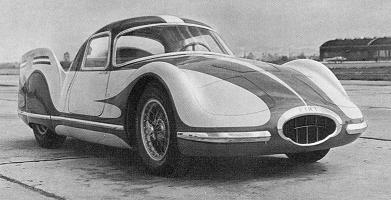
Presented for the first time at the 1954 Turin Motorshow,
the Fiat Turbina was a one-off prototype for a sportscar powered by a gas
turbine engine. The sole Turbina built can now be seen in the Biscaretti
Museum in Turin.
It was first studied several years earlier in 1948, the
design being chosen in 1950. With the engines being defined in 1953 it first
ran at Lingotto in April 1954. The body was a two seat coupé with some
resemblance to the 8V.
Much attention was paid to the aerodynamics and an excellent coefficient of
drag was supposedly achieved.
The engine itself used a two-stage compressor and a
three-stage turbine. Of the latter, two drove the compressors whilst the third
drove the rear wheels through a reuction gearbox.
Technical Details
| Driveline | mid engine with rear wheel drive |
| Engine | gas turbine with 300bhp @ 22,000rpm |
| Suspension | front : Independent with double wishbones, coil
springs and telescopic dampers rear : independent with double wishbones, coil springs and telescopic dampers wheelbase : 2400mm track (front/rear) : 1296mm/1297mm |
| Brakes | drums all round |
| Gearbox | reduction |
| Empty weight | 1050kg (full : 1270kg) |
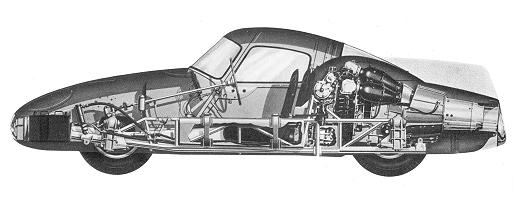
|
|
|
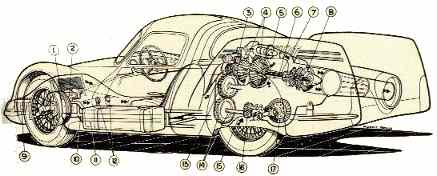
|
|
Einige Artikel:
|
Nel 1954 la Fiat fu la prima casa automobilistica in Europa a presentare una vettura azionata da turbina a gas. Il progetto non nuovo nel mondo della auto, (General Motors e Chrysler avevano già presentato auto con motori a turbina) richiese un lungo periodo di progettazione, gli studi cominciarono nel 1948 e finirono con la prova "su strada" il 14 aprile del 1954 sulla pista del Lingotto. L'unità motrice era formata da un compressore a due stadi, turbina a due stadi, turbina motrice a uno stadio e relativo gruppo riduttore per la trasmissione alle ruote. La turbina forniva una potenza di circa 200 cv al regime di 22.000 giri. Il telaio era a 4 ruote indipendenti, senza cambio di velocità, essendo il funzionamento della turbina simile ad un convertitore idraulico. La struttura del telaio era formata da elementi tubolari, la sospensione anteriore derivata dalla Fiat 8v. Ai lati del telaio al centro della vettura tovavano posto i due serbatoi carburante. La carrozzeria bellissima, con le due pinne stabilizzatrici posteriori e la parte posteriore che racchiudeva il propulsore, completamente asportabile. Il peso totale raggiungeva i 1000 kg. la velocità massima stimabile attorno ai 250 km ora. Dopo le prove del 1954, la splendida Fiat a turbina venne messa a riposo, il sogno di utilizzare questi motori nel campo automobillistico svaniva, rimane per fortuna questa splendida realizzazione. |
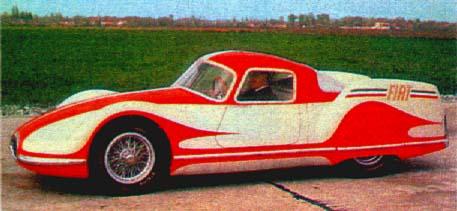
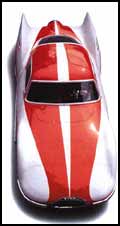
The idea of using gas turbines as a source of power for automotive transportation started being concretely developed in the depression era . Turbine's main advantages were well known : high amount of power with a small unit, usage of any flammable liquid as fuel and maximum torque available at 0 rpm. But disadvantages of turbines emerged rapidly too. High exhaust temperatures, difficult regulation of gas flow, noise and first of all fuel consumption. This problem is mainly due to a fundamental property of all turbines: the drastic reduction of efficiency when rotor is not working at a constant and fixed value of rotational speed. This aspect, absolutely non compatible with car powerplants typical way of working, still prevents turbine from substituting conventional engines.
In 1954 Fiat was the first European company to develop a turbine powered car. Studies began in 1948 and ended with first road test on the 14th of April 1954 on Lingotto's oval track. Powerplant was composed of a twin-impeller compressor powered by two separate turbines which fed combustion chamber. Main turbine, mounted just after the chamber was directly geared to wheels. No gearshift was required since turbine works like an hydraulic torque converter. Engine provided about 200HP at 22000 rpm. The Turbina had tubular chassis and independent wheels suspension, derived from Fiat 8V. On chassis' sides, in central position laid two 50 litres fuel tanks but car's total weight was only 1000 kg. Typical 50's bodywork included two big tail fins and jet-like exhaust. Maximum esteemed speed was about 250 km/h, but the project was abandoned immediately after first road tests.
Turbina's back, showing jet-like exhaust. Non-regenerative turbines like the one used for this prototype expel gases at several hundreds of °C. Imagine what may happen to scooter riders waiting behind this car at a traffic light !!
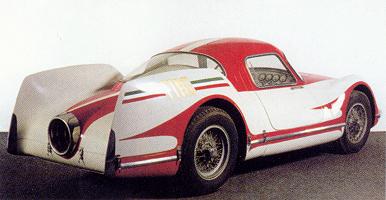
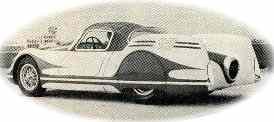
Fiat mod. Turbina - 1954
Prototipo sperimentale di vettura azionata da turbomotore a gas, presentato dalla FIAT nell'aprile del 1954. Il propulsore è costituito da un compressore centrifugo a due stadi accoppiato a una turbina pure a doppio stadio e ad una turbina motrice collegata a un gruppo riduttore a ingranaggi per la trasmissione del moto alle ruote. Carrozzeria berlinetta a due posti di efficace profilatura aereodinamica, sperimentata su piccoli modelli in scala nella galleria del vento del Politecnico di Torino. Le prove tecniche di funzionamento furono effettuate sulla pista del'aereoporto di Caselle.
Motore: a turbina
Potenza: 300 CV
Regime di rotazione: 22000 giri/ min.
Velocità: 250
Typenreihe
Turbina |